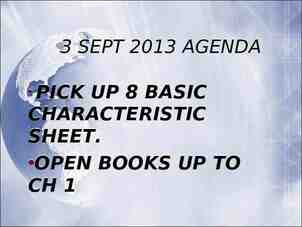Introduction to Business
46 Slides514.00 KB

Introduction to Business

HOMEWORK 1. Read Chapters 5 & 6

OBJECTIVE Be able to define the term “Business”

“Business” An activity that satisfies economic needs by planning, organizing, & controlling resources to produce & market goods & services

Business An activity . . . that satisfies . . . economic wants & needs . . . by planning, organizing,

Business & controlling . . . resources . . . to produce . . . & market . . . goods & services.

“Business” (Revisited) An activity that satisfies economic needs by planning, organizing, & controlling resources to produce & market goods & services

Business Activity For the businesses listed below, explain how each meets the definition of business: – McDonald’s – Nichols Hardware – Food Lion – Google – (Your Choice)

OBJECTIVE Be able to describe the three functions of business

Three Functions of Business Production Marketing Management

Three Functions of Business Production - Creating, growing, manufacturing, or improving products Marketing - Activities that move goods/services from producers to consumers Management - Achieving company goals by directing its resources (Make or else!!!)

OBJECTIVE Be able to define the term utility & describe all of the different types of utilities

UTILITY Defined as “value added”

UTILITY TYPES How we “add value” Form Place Time Information Possession

UTILITY TYPES How we “add value” Form: - changing item’s shape or creating item Place: - By putting a product where the consumer can get it easily Time: - By making an item available when the consumer needs it Oil, for example

UTILITY TYPES How we “add value” Information: - By letting people know how the item will benefit them Possession: - By allowing people to own the product Oil, for example

UTILITY TYPES How we “add value” to the computer Form: - By changing an item’s shape or creating an item Place: - By putting a product where the consumer can get it easily Time: - By making a product available when the customer needs it

UTILITY TYPES How we “add value” to the computer Information: - By letting people know how the item will benefit them Possession: - allowing people to own the product

OBJECTIVE Be able to describe the “social responsibilities” of a business including its ethical treatment of customers

Social Responsibility & Ethics Social Responsibility - What a business “should” do in the eyes of the majority of the population Ethics - Guidelines for “good” or acceptable behavior in the eyes of the majority of the population

Areas of Social Responsibility Consumption of Natural Resources – Use of resources & recycling efforts Environmental Issues – Damage to & protection of the environment Worker Issues – Treatment (handicapped, health-care, etc.) – Pay (amounts, docking, profit-sharing, telecommuting, etc.)

Areas of Social Responsibility Consumerism - “Using legal, moral, & economic pressure on business protect the consumer’s rights ” – To be protected against fraud, deceit, & misleading statements & to be educated in wise financial decisions – To be protected from unsafe products – To have a choice in products & services – To have a say in product/marketing decisions

LEGAL CONSIDERATIONS Statutory Law - Laws that are written by congress or other ruling bodies & then enforced by law enforcement institutions (police, FBI, etc.)

LEGAL CONSIDERATIONS Common Law - Laws that are based on the actions of a “reasonable person,” often determined in court. (negligence, for example)

OBJECTIVE Be able to define “Entrepreneurship” and identify its advantages & disadvantages

ENTREPRENEURSHIP Owning & operating your own business

ENTREPRENEURSHIP Owning & Operating Your Own Business Advantages Disadvantages Discussion

ENTREPRENEURSHIP Owning & Operating Your Own Business Advantages – Freedom – Satisfaction – – Self-Esteem Disadvantages – RISK!!! – Loss of income – Long & irregular hours – Need for selfdiscipline

OBJECTIVE Be able to describe the most common personality traits of successful entrepreneurs

ENTREPRENEURS Personality Traits of Successful Entrepreneurs: (Discussion)

ENTREPRENEURS Personality Traits of Successful Entrepreneurs – confidence – skill – risk-taker – competitive – determined – hardworking

ENTREPRENEURS Personality Traits of Successful Entrepreneurs – flexible – disciplined – healthy – experienced – goal-oriented – people-person

OBJECTIVE Be able to describe the three major types of business ownership & discuss their advantages & disadvantages

SOLE PROPRIETORSHIP Owned & operated by one person (Usually highly skilled) – employs 95% of the workforce – examples include plumbers, dentists, beauticians, small shop owners, etc.

PARTNERSHIP Two or more people legally agree to share the ownership & responsibilities of a business

CORPORATION A charted (legal) entity that operates apart from the owners – the corporation will often sell stock – the stockholders will elect a board of directors to run the company

CORPORATIONS (Discussion) Doctors will often incorporate their practice; Why? (Discussion)

SOLE PROPRIETORSHIP Advantages Disadvantages (Discussion)

PARTNERSHIPS Advantages Disadvantages (Discussion)

CORPORATIONS Advantages Disadvantages (Discussion)

SOLE PROPRIETORSHIP Disadvantages Advantages – capital ( ) is – easy to start limited – decisions are easy – can’t have to make “group-think” – low taxes – no help – fewer gov. available w/ regulations other skills – you get all the – big Risk money!!

PARTNERSHIPS Disadvantages Advantages – more ideas & – more ideas & opinions opinions to to consider (?) consider – harder to make – you have help to decisions run the business – personally at risk – the risk is shared – death of a partner – more capital causes problems available

CORPORATIONS Advantages – liability is limited to your investment – it is easy to raise more capital (sell more stock) – it is easy to get into & out of the corporation (sell or buy stock) Disadvantages – often a complex & changing ownership picture making decisions difficult – highly regulated – higher tax rates

OTHER FORMS OF BUSINESS OWNERSHIP Franchise: – a legal agreement to operate a business in the name of a recognized company . Advantages Disadvantages Franchisor offers help Expensive to buy Planning already done Limited creativity

OTHER FORMS OF BUSINESS OWNERSHIP Subchapter S Corporation: – A small business taxed like a sole proprietorship or partnership but w/ limits: » No more than 35 stockholders » Incorporated in the US » Max. 20 % of income comes from investments » Max. 80% of revenue comes from overseas

INTRODUCTION TO BUSINESS Quiz Review






